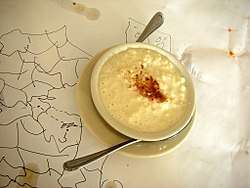Kamby arro
Kamby arro is a popular dessert in Paraguay. It is a thick cream obtained from cooking rice and cow's milk according to a precise process.
 | |
| Type | Pudding |
|---|---|
| Place of origin | Paraguay |
| Serving temperature | Cold |
| Main ingredients | Cow’s milk, water, rice, sugar, lemon zest, cinnamon |
Origin of the name
The name in Spanish relates directly to the two ingredients that make its preparation, milk (leche) and rice (arroz).
The name in Guaraní, “kamby arro” results in the same way, from the conjunction of the two words for its ingredients, "kamby" (milk) and "arro" (rice).
Ingredients
There are different ways to prepare kamby arró, so the ingredients vary according to each version.
The most traditional one uses cow’s milk, water, rice, sugar, lemon skin and cinnamon.
Preparation
The rice is washed and poured in a pot with milk, sugar, water and lemon skin.
Then, the mixture is allowed to boil slowly until it acquires a thick texture, mixing it occasionally whilst avoiding the
When it becomes a creamy mix of rice and milk, it is served in little containers. Then is when the cinnamon powder is dusted on the cream. The “kamby arró” must be served cold.
Interesting facts
There is a variant in the preparation of the kamby arró in which vanilla is added to the ingredients mentioned above, obtaining a different flavor.
In the Paraguayan country-side the kamby arró is considered nutritious and great para la cabeza (special to improve the intelligence) because of the use of the cinnamon (Cinnamomum zeylanicum or Cinnamomum verum, a tree of perennial leaves of about 10 or 15 meters tall, originally from Sri Lanka and from which its internal cortex is used as spice, extracted by peeling and rubbing its branches. It is used indistinctly in branches or in powder).
Notes
- According to some scholars of social history of Paraguay, all the Paraguayan popular gastronomy, which establishes itself as a small family industry after the War of Paraguay against The Triple Alliance (Argentina, Brazil and Uruguay, between 1864 and 1870), is really abundant in caloric content, because of the situation that overcame to the country after the conflict. In the aftermath of the war the food was limited and the groceries were hard to find. So Paraguayan cooking has a high protein content to make up for the scarcity of every day meal.
References
- “Tembi’u Paraguay” de Josefina Velilla de Aquino
- “Karú rekó – Antropología culinaria paraguaya”, de Margarita Miró Ibars